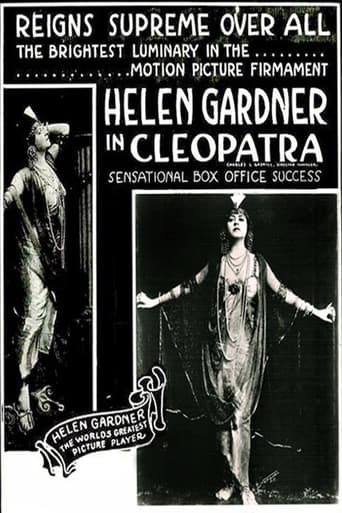arfdawg-1
The Plot. When she discovers that a slave named Pharon professes his love for her, Cleopatra makes a bargain with him: she will give him ten days of "love," at the end of which he is to commit suicide. He agrees, although the queen's handmaiden Iras, in love with the slave, isn't happy with the arrangement. Later when Cleopatra is seducing Marc Antony, her relationship with Pharon is used against her, but with little effect. She allies herself with Antony against Octavius, participates in a brief war, then meets her end rather than be subjected to Roman rule.Wow. This movie is BAD. It is amateurishly filmed -- even for 1913. Also the focus is really odd. I don't think it was just the print. i think it was intentional. The entire mo0vie looks like it was filmed at the Château marmont, only it wasn't built yet.I had never heard of Helen Gardner before seeing this film. How she got her own production company is beyond me.
michael.e.barrett
I'm amazed to see a 1912 feature that's almost 90 minutes long. By contrast, "From the Manger to the Cross" is under 70 min. The tinting and restoration are good, the modern music by Chantal Kreviazuk is interesting if unnecessary (there's no reason to be turned off by it--you can always play your own music!). The film is not in "pure" tableau style but in modified tableaus. That is, there is some cross-cutting from different locations, and dialogue cards do interrupt the shots. The first scene is even somewhat distracting in its cutaways to a man who is a short distance away. During the battle of Actium, the camera suddenly goes in for a series of near close-ups of Cleopatra and Antony from the waist up, and the entire scene is told in these alternating shots with captions. (A way to avoid staging a battle.) The scene in which she barges down the Nile and seduces Antony is a typical example of "film d'art" tableau style, with only dialogue interrupting the shot occasionally. The major lengthy sequence at the end, however, begins in two locations: in Cleo's chamber on an upper floor and outside on the ground below, and Antony is raised up through the window on a rope, then for the rest of the complex scene the camera pans right and left as called for by the action. Fascinating and typically noble.
DLewis
Producer-star Helen Gardner has doubtless seen the Italian "Quo Vadis", and this "Cleopatra" runs an amazing 90 minutes for a 1912 feature (with 106 title cards!) "Cleopatra" is a case of trial and discovery in this exploratory era of American features. The first hour is filmed in the static "Film d'Art" style, save for one brief insert added probably very late in the production, and the modern viewer begins to wish that the camera were moved even just a bit closer to the stagebound action, despite the elaborate, if somewhat primitive, stage dressing. In the last third of "Cleopatra" more shots and setups are used, by far, than in the first two thirds. We also find the camera is moving closer to the actors and less of a concern is shown towards exposing the sets, costumes, and extras, resulting in an entirely more satisfying and intimate cinematic experience, though some of this section of the film is choppy in the GEH print aired on TCM. My feeling is that "Cleopatra" is a textbook example of how feature-length filmmaking helped open up possibilities towards a more sophisticated style of onscreen direction, cutting and camera setups. Gardner & co. are literally discovering as they go, and it seems much of "Cleopatra" was filmed in story sequence. By shooting using gradually smaller parts of the set, and closer to the actors, Gardner created a film that had considerably more dramatic power in the end result than was generally required by 1912 standards, and on this alone the film remains a genuine step-forward for the fledgling American feature industry.
silent-12
I just saw this version of "Cleopatra" as part of TCM's Women Pioneers in Film Series. Although I think they did a beautiful job on the restoration, I found the new, avant-garde soundtrack too invasive and distracting. In fact, I had to watch it with the mute on.Having said that, though, I did find this adaptation interesting. It is true that, like many films of this era, it is a bit creaky and primitive. However, it provides a fascinating glimpse of early filmmaking--no closeups, the camera hardly ever moves, etc. I also found Ms. Gardener fascinating, given how much of the production was actually done by her, including costume design. I wish there were more information available on her life and career.

